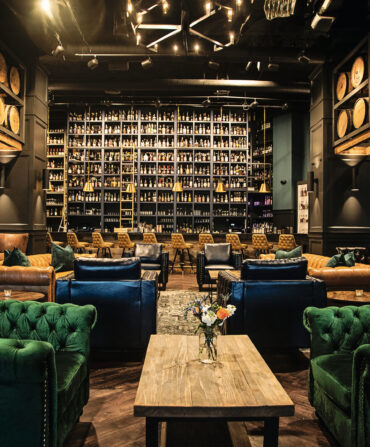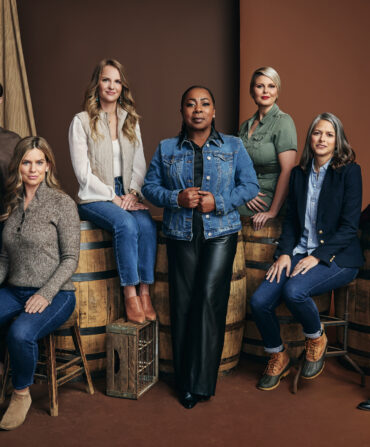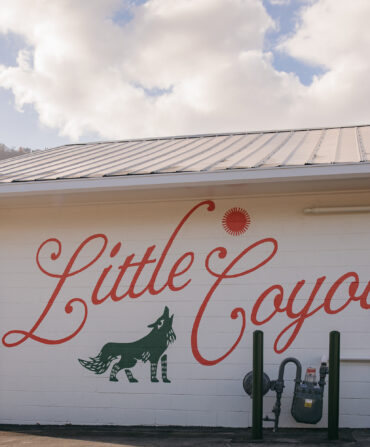Food & Drink
The Hashmasters
A culinary road trip through rural South Carolina in pursuit of smoke, fire, and the lost art of making barbecue hash
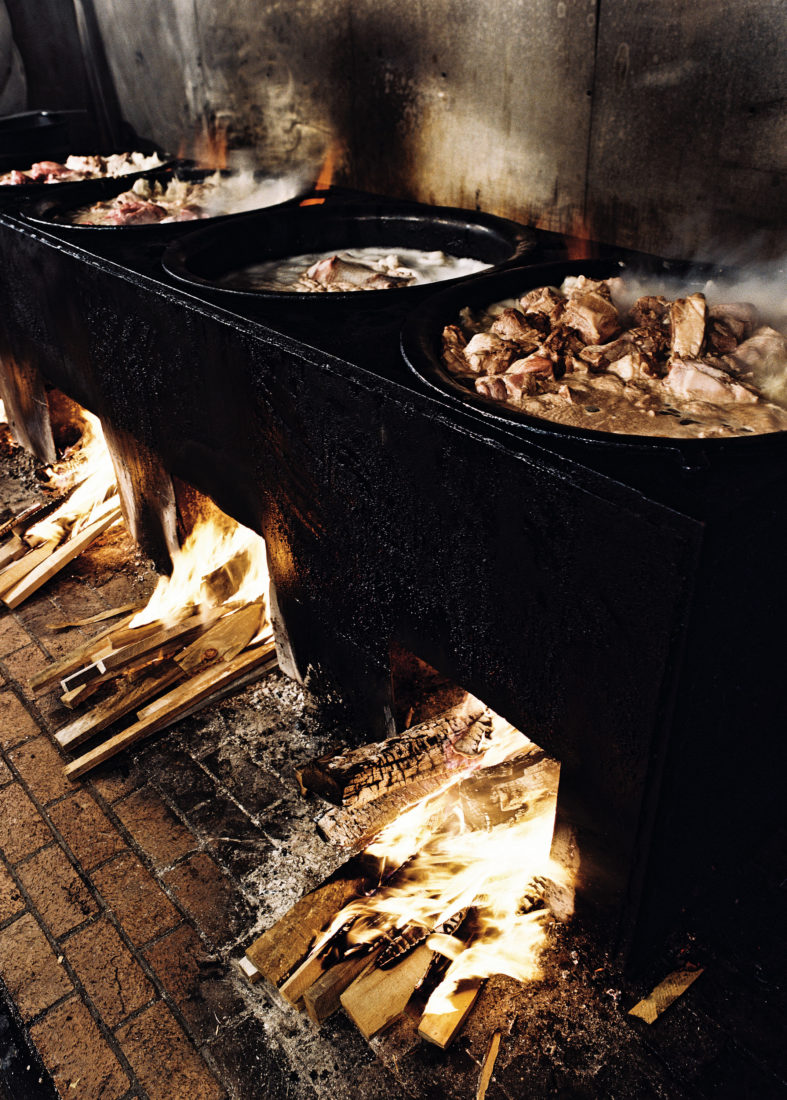
Photo: Peter Frank Edwards
Gary Wise ushers me into the open-air cookhouse behind his restaurant, where the air is hazy with vaporized grease. At the end of a row of cinderblock pits, I quickly spot what I’m looking for—a man-size ninety-gallon cast-iron kettle. This is where they cook the barbecue hash.
If you’re unsure of exactly what I’m talking about, you’ve got plenty of company. This unsung side dish of stewed pork served over rice has been eaten in South Carolina since the colonists first learned how to slow-cook a hog, but few outside the state have ever tasted it. We’ve got more distinct barbecue styles (four sauces) than any other state in the country, and hash is no different—the approach can radically change depending on the terrain. This Saturday morning I happen to be in upper Newberry County, in the district between the Broad and Saluda rivers that was first settled by German families and is still known as the Dutch Fork. Here at Wise’s Bar-B-Q, hash is made with pork shoulders drenched in mustard, apple cider vinegar, and black pepper, and then stirred with a paddle for eight hours or so until the stewed meat has broken down to its elemental strands. Hash is the first thing you’ll find on the self-serve buffet at this barbecue joint or any other north or west of Columbia, and the dish is critical to a barbecue restaurant’s statewide prestige. Good hash is harder to find than good barbecue, which isn’t exactly easy to track down.
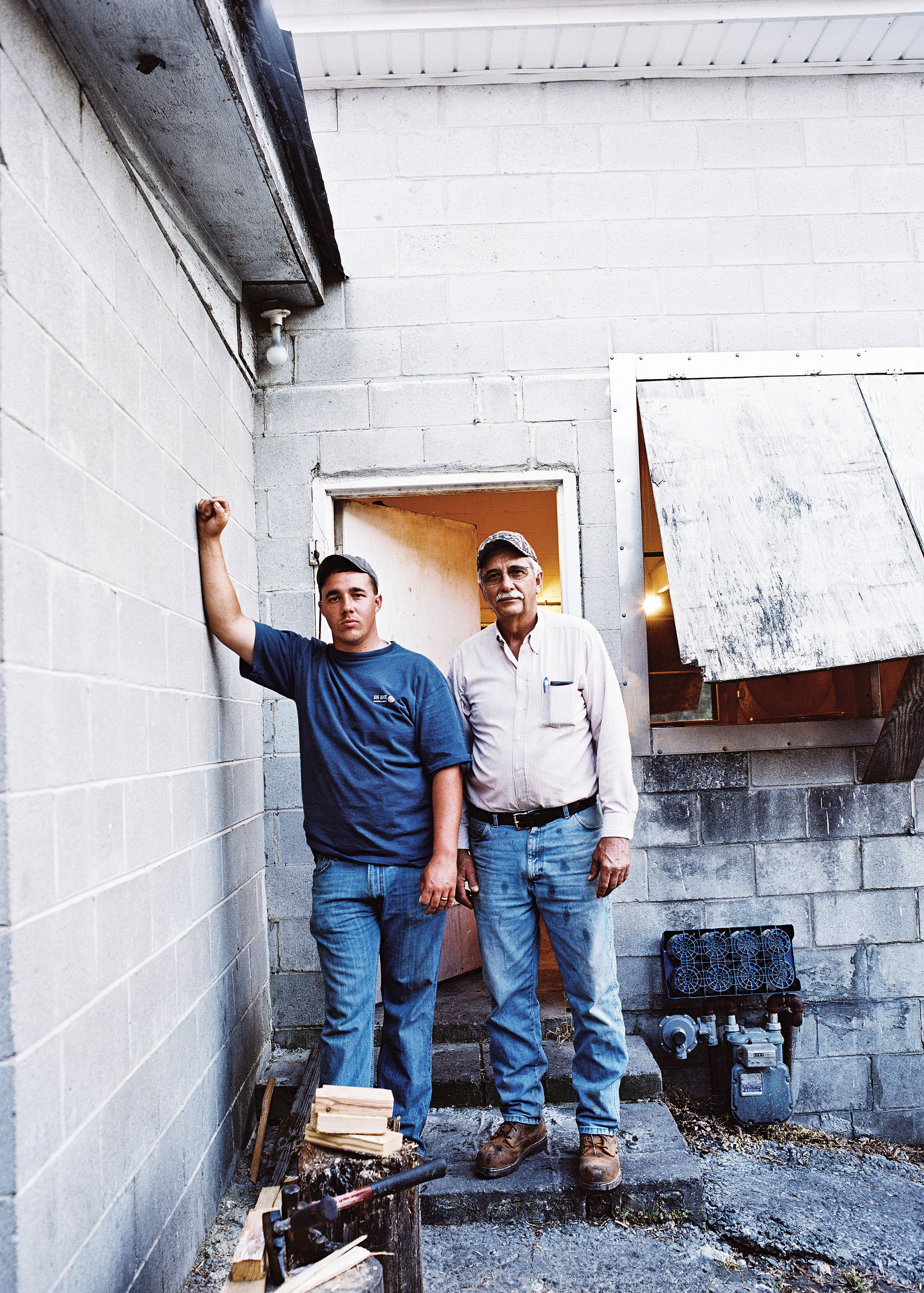
Photo: Peter Frank Edwards
Robert and R.J. Dowd outside their Newberry County hash house.
That might explain why I drove 150 miles to this cinderblock hut on a desolate stretch along Highway 76 to wait in line for lunch. Despite the Internet age, the only place you can find this hash is at the restaurant, and Wise’s Bar-B-Q is open only two days a week. The one kettle of hash Gary Wise makes every week is gone by Saturday evening—if not before. When I ask the laconic forty-year-old if he ever ships the stuff, he strokes his mustache for a moment, eyes scrunched.
“Nah. It’s too much trouble.”
Since his father, Johnny, and uncle Jimmy first opened the joint forty years ago, little has changed in the restaurant aside from one small detail. The wood fire beneath the hash kettles and in the hog pits has been replaced by gas flame. In the past twenty years or so, most barbecue joints have switched to cooking with gas, thanks to its stable temperature and shorter prep time, so I would have been impressed if they were still shoveling hickory coals under the pot. Few realize that wood smoke is as critical an ingredient to a good hash as mustard, but that’s exactly what I’m looking for. At the very least, Gary Wise still makes mustard hash in the original cast-iron kettle, which after four decades is seasoned with the kind of patina found in a favorite frying pan. That pleasant spike of vinegar mixed with hints of ash and iron sends a familiar shiver through my palate, triggering memories of summer dinners with my grandparents on the back porch and bachelor feasts made from frozen quarts bootlegged to a ramshackle apartment in New York City.
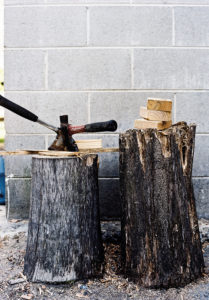
Photo: Peter Frank Edwards
Kindling for the hash fire.
Twenty miles away in Laurens County, I find Lee’s Barbeque & Catering, a sprawling restaurant on a bluff above Lake Greenwood at the very edges of the Dutch Fork district. Co-owner Buddy Lee, the third-generation hashmaster and impresario, leads me into the depths of the cavernous kitchen to see the heart of the operation. It is frustratingly twenty-first century, with no firewood in sight. The one-hundred-gallon cast-iron kettle used by his father, Sid, has been replaced by a sleek, freestanding sixty-gallon stainless-steel Groen cooker. Hot batches of Lee’s affably mild hash are poured into plastic containers and carted into a sophisticated walk-in freezer. “Then we freeze-blast it,” announces Buddy with unconcealed joy. This advanced process allows him to ship “Lee’s Big Butt” hash to area grocery stores and across the world. Fans include Canadian Indians, Argentine hunting guides, and a wild uncle in California known for his hash burritos.
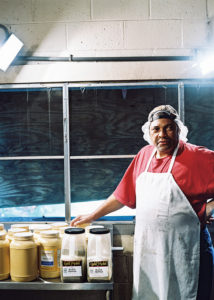
Photo: Peter Frank Edwards
Dowd’s employee Willie Koon.
There is another small wrinkle to this modest dish: All these old hashmasters have held down other careers. They originally cooked hash and pulled pork for side money, and the good ones eventually made a career of it. On my way out the door, I happen to notice an old black-and-white picture of two men in uniform. Buddy explains that the man on the left is his grandfather Sidney Lee, who gained his reputation as a master cook when he was a Laurens County game warden. The holiday barbecues prepared at the warden’s cabin led to the opening of this restaurant. Then I ask the name of the warden beside him.
“Oh, that’s Herman Wise,” exclaims Buddy. As in, the cousin who taught Johnny and Jimmy Wise how to cook serious barbecue. It’s pure accident that I visited both families on the same afternoon, but no less appropriate. Whether slow or swift, change has come to the back roads of South Carolina, and I would have to keep driving to find what I was after.
In Stan Woodward’s fascinating documentary Carolina Hash, the noted filmmaker sought out folks still cooking hash the hard way—in a cast-iron kettle over wood coals. The formula was as simple as the ingredients, but his quest to preserve this vanishing tradition brooked no compromise. Until I began this tour, I did not appreciate the sheer amount of labor required to make this dish, or that it was growing harder to find wood-fired kettle-cooked hash by the day.

Photo: Peter Frank Edwards
Wise's Bar-B-Q outside Jalapa, South Carolina.
More determined than ever to track down some traditional hash, I head fifty miles southeast for the mustard-basting capital of Lexington County. Soon enough I find myself at the doorstep of Jackie Hite’s Bar-B-Que on the backstreets of Leesville, South Carolina. I don’t need to check the buffet to confirm the house style is mustard; you can smell the tang in the air and see the yellow fingers of all the boys gnawing at their basted ribs. After some mumbling, the good ladies behind the counter hand me a quart of Jackie Hite’s “Old-Time Stringy Hash.” This stuff is so good you could eat it hot, cold, or with a plate of dirt.

Photo: Peter Frank Edwards
Carolyn Dowd inspecting the hash.
But Jackie Hite is not a young man, and after his open-heart surgery three years ago, he had to give up cooking hash over hickory coals. The threat of a heart attack is about the only thing that would keep this die-hard seventy-year-old hashmaster from doing things the way his father taught him. Jackie assures me that he still cooks his pulled pork over hickory coals, and despite his doctor’s orders, he still heaps coal beside his seventy-eight-gallon cast-iron kettle simmering over a blue flame. “That puts a smoke flavor to the hash,” he says. After explaining how it gets twice-cooked and continually stirred for nearly ten hours, along with some secret ingredients, he confides something to me.
“Nobody makes hash harder than we do and loves it more.”
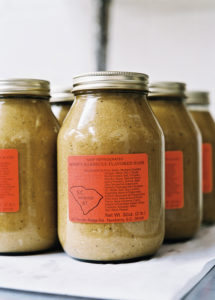
Photo: Peter Frank Edwards
Jars of the real stuff from Dowd’s.
That may be true, but there’s got to be somebody out there still cooking over nothing but wood coals, and by God I am going to find him. My tour comes full circle back to Newberry County before I finally find what I’m looking for. The object of my pursuit, it turns out, shows up not at a restaurant buffet but on a small shelf at a local Food Lion, where Dowd’s Bar-B-Que Flavored Hash is sold by the pint or quart. Even with the blaze-orange labels, these jars are difficult to find, but I finally stumble onto the display in the refrigerated food section beside the smoked sausage and pimento cheese. Tracking down Dowd’s headquarters on the outskirts of Newberry is harder still. There is no sign visible from the road, and the cinderblock “hash house” is well disguised among a handful of unpainted outbuildings. I pass the driveway three times and am still uncertain if I’m trespassing until Robert Dowd introduces himself with a modest smile.
This gentleman with a graying mustache and hunting cap isn’t sure what to make of my interest. He runs a wholesale operation and is unaccustomed to meeting average customers, let alone someone crazy enough to drive several hundred miles for a quart. To be honest, I’m not even sure what it is about this particular hash that keeps luring me off the highway until he leads me into the back room of the low-slung hash house, and it hits me like a load of kindling. There are four fifty-gallon cast-iron kettles housed in a continuous steel frame. The floor beneath is paved with pale firebrick, and wood smoke hangs heavy in the air.
At Dowd’s, they cook their hash over red oak and hickory coals fed from a rack of logs along the back wall. Like many hashmasters, Robert Dowd also has a full-time job—he runs a pallet operation, and pine slats from the busted pallets are used for fire starter. The burning ends protrude from the glowing scuttles beneath each kettle, and the thick mustard hash is already bubbling away.
Dowd’s recipe is just as confoundingly simple as the others I have tasted: pork butts and shoulders stewed down to their finer strands, mustard, coarse black pepper, salt, and a little bit of margarine to slick the pot. The only preservative is the rubber seal on the mason jar. Robert and his family make about eight hundred quarts twice a month. Cooking begins on Tuesday evening, often running past midnight. On Wednesday morning, the cooled meat is separated from the gristle and added with spices back to the waist-high hash kettles. Then the Dowds light the fires a second time.
The entire family has convened at the little hash house as they do twice every month. Robert’s twenty-five-year-old son, R. J., supervises stirring the kettles. This full-time fireman has dutifully scheduled his shifts at the firehouse around the mid-week hash-making. As with his father and the rest of the family, this may not be his full-time job, but it is certainly a lifelong commitment.
“A lot of people think this is a really hard process,” R. J. says, “but my daddy’s been doing it for fifty years—maybe longer—and I’ve been doing it for twenty. We grew up around it and know what to do and when to do it.”
Little has changed since Robert Dowd’s father first made his version of mustard hash in twelve-gallon kettles at the farm’s old smokehouse back in 1955. They still use the same recipe and have stubbornly resisted all but the most necessary modernizations. Robert’s wife, Carolyn, who runs the prep area, has a particular aversion to the pumps that might save them a few hours of work at the cost of losing the opportunity to chat with her family around the prep table. When the hash is finished cooking, they fill and inspect every jar by hand.
“I tell people that we eat this hash, too,” she says.
In the back room, a pair of helpers take turns stirring the stewed meat with a narrow steel paddle. When a thick brown band rims the tops of the hash pots, the fires are doused. R. J. ladles the hash into the last original twelve-gallon pot, which sits in a customized steel frame, and slowly wheels it into the climate-controlled prep room. R. J. fills the jars and passes them down the family assembly line. The lids are sealed, the glass inspected, and the jars added to the racks for shipment. Before the end of the day, eight hundred glass quarts will make their way to the towns of the Dutch Fork.
Before I leave, Robert takes me out back to the tiny smokehouse where this operation first started. This was where he watched his parents make hash when he was a small boy. Now his young grandson is already eager to load firewood under the kettles. For the near future, somebody will be firing the cast-iron kettles in this corner of the state. What if nobody knew to thank them for their tireless burning and stirring? It begs a fundamental question about the tradition of this modest dish that I can’t help but ask.
“Has anyone ever called you a hashmaster?”
He seems startled by the term and offers a bemused grin.
“No,” he says, chuckling. Eager to change the subject, Robert checks his watch and cocks an eyebrow. It’s past lunch, and he must know I’ve got some miles to cover.
“You want to take a quart of warm back with you?”
Around here, even the word hash goes without saying.


